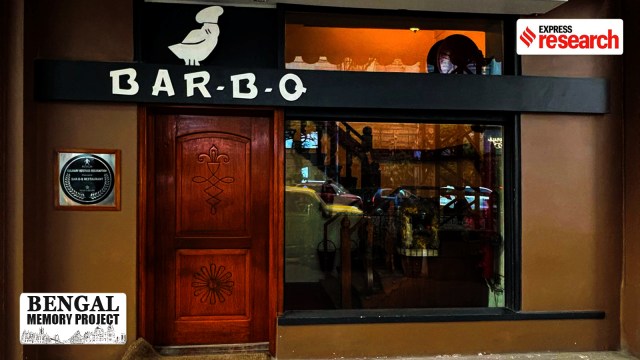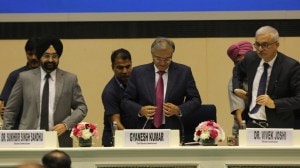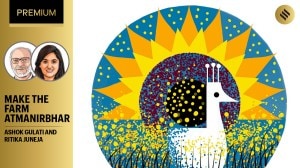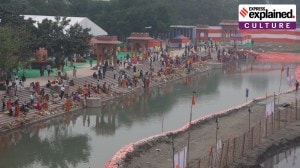It is a bustling Wednesday evening on Park Street, with pedestrians rushing to the IIHM Metro Station and cabs queuing on either side of the street to pick up passengers. Most are returning home after a busy workday, yet a dedicated group can be found walking to their favourite restaurant for dinner. Located on an expansive first floor, with a rustic wooden interior, quaint lamps, and an iconic table mat that describes your spirit animal, the restaurant is called BarBQ.
Almost six decades ago, however, Viraj’s great-grandfather Shivji Velji Kothari had a different vision for the place. In 1962, he rented a small room on the ground floor of the building that houses the restaurant today, then owned by a German, and set out to introduce Calcutta to a premier rotisserie (roasted food) experience — hence the name “BarBQ.”
Shivji laid the foundation for what would later become two of Calcutta’s legendary dining destinations: Mocambo & BarBQ, both celebrated for their North Indian, Chinese, Continental and Italian cuisine. At a time when Park Street was bustling with European entrepreneurial ventures, Shivji stood out as a visionary, forever redefining the city’s culinary landscape.
1947, Karachi, Pakistan
Shivji, along with his six children, lived in Karachi. Life was stable and prosperous until the 1947 Partition. “My father-in-law, Shivji Kothari, owned several properties in Karachi and was a well-respected figure in the city’s bureaucratic circles,” recalls Malti Kothari. Reflecting on those turbulent times, she says that her father-in-law was deeply concerned about how he would provide for his children if he fled to India. Rather than risk their future, he made the difficult decision to stay behind in Karachi, hoping to liquidate some of the wealth he had built over the years. “He sent his wife and children to Bombay but remained in Karachi to sell off his properties. For his safety, he wore the Jinnah Cap.”
Today, Malti Kothari resides in Calcutta, where she married Shailendra Shivji Kothari, the son of Shivji Kothari, in 1958.
“Shivji spent his time in Karachi selling off his properties, all while maintaining his connections with the city’s elite, whom he would host for dinner in the evenings,” she recalls. After selling his last property, Shivji headed straight for the airport, determined to board the next flight to Bombay. On that fateful day, his identity as a Hindu became known throughout Karachi.
Story continues below this ad
The airport authorities soon received calls instructing them to stop the flight which he was aboard. “The bureaucrats and politicians realised Shivji Kothari was a Hindu, living in disguise all this while. They wanted him killed,” says Malti. “Having once been the president of the flight club, my father-in-law was not only familiar with the flight operations but also managed to convince the Scottish pilot not to halt the plane,” she explains. And that’s how the icon of Calcutta’s food and beverage industry made his way to India.
In Bombay, Shivji and his family were graciously hosted by their friends, the well-known Kilachand Devchand family. After a month, they moved to Pune, where they stayed for another six months. During this time, Shivji managed to secure a flat in Bombay, and the family moved back. Not long after, he successfully acquired a contract to run the airport restaurant.
1950s, Calcutta, India
The family eventually secured the airport restaurant contract in Calcutta and relocated there. They initially rented a house on Middleton Street before later buying a flat in Stephen Court on Park Street.
Story continues below this ad
Navpreet Arora, a heritage enthusiast and founder of the walking tour company Funonstreets, notes, “Although Park Street in the 1900s was a jungle where most of the city’s cemeteries were located, things had changed by the 1950s.”
Reflecting on the century-long transformation of the locality, Navpreet says: “While the neighbouring Dalhousie Square was home to the European elites and was regarded as ‘White Town’ since the mid-19th century, Park Street was considered the outskirts.” As Dalhousie Square became overcrowded, Navpreet explains, the affluent moved to suburban areas like Garden Reach and Alipore in South Calcutta, while the working class began settling in Park Street and its adjacent neighbourhoods, such as Camac Street.
“If you look at old directories, you’ll see that Camac Street was once referred to as ‘Dunkun Basti ka Rasta,’ implying a slum road,” she adds. “However, it’s important to note that there were also well-off families in the area. For example, Loreto House School was once the residence of British judge Sir Elijah Impey.”
Over time, Park Street became home to many grand mansions, including Park Mansions (1910), Queen’s Mansion (1920), and Stephen Court (1923) — architectural marvels built by the city’s Armenian diaspora. Witnessing the area’s growth, a Swiss couple, Joseph and Freida Flury, opened their Swiss confectionery and tea room, Flurys, in 1927. They later partnered with fellow Swiss, Quinto Cinzio Trinca, to open the legendary restaurant Trincas.
Story continues below this ad
Although the partnership ended in 1939, Navpreet believes their success inspired others to open restaurants in the area by the 1950s. “And gradually, Park Street transformed into the glitzy, glamorous street we know today.”
The Birth of BarBQ
Taking the lead and competing with the European-run ventures was Shivji Kothari. While managing the airport restaurant, he opened his first establishment, Mocambo, on Park Street in 1956.
During a subsequent holiday to Europe, Shivji became fascinated by the concept of rotisseries, which had gained popularity in France since the 15th century. A rotisserie is a cooking device used for roasting, where meat is skewered, usually on a horizontal rod, and slowly rotated over a fire. This rotation ensures even cooking, resulting in a tender and flavourful dish.
Inspired by this idea, Shivji decided to introduce it to Calcutta. “He bought a rotisserie machine and, in 1962, opened BarBQ in a rented space on Park Street with a capacity of 50-60 people,” Malti said. However, the concept of grilled food didn’t quite resonate with the local palate, as people were more accustomed to their rich, spicy flavours.
Story continues below this ad
She recalls that while Shivji was initially disappointed by the restaurant’s lack of success, he quickly adapted, transforming BarBQ into a place offering Chinese, Indian, and continental cuisine. “We had excellent chefs who came from China, and my children affectionately called one of them ‘China-man!’” she laughs.
Over time, Shailendra Kothari began overseeing the operations of BarBQ. “My husband had a very good relationship with the landlord, who advised him to purchase the space, which was owned by a German and was up for sale.” The Kotharis then traveled to Munich, Germany. “After much persuasion and negotiation, he finally agreed to sell us the space,” she sighs.
Over time, BarBQ expanded and now operates its Indian restaurant under the name of BarBQ, while the adjacent room serves Chinese cuisine under the name of Flavours of China.
Story continues below this ad
‘A place we never disagree to go to’
Regulars now spot a new, young face — Viraj — taking rounds of the restaurant, attending to special requests, and resolving customer concerns. For years, it had been his father Rajiv Kothari and grandfather Shailendra, doing the same. “The reason BarBQ has remained a favourite among Calcuttans is because the boss is always there. My husband was always there, Rajiv was there, and now Viraj,” exclaims Malti. “It has taken years of hard work to make BarBQ what it is today,” she says, her voice trembling with nostalgia.
 Bar-B-Q mini kulchas (Source: Viraj Kothari)
Bar-B-Q mini kulchas (Source: Viraj Kothari)
Viraj, who spends most of the time at the restaurant, excitedly adds, “We were the first to transform tutti frutti, the fruity gummy bears, into a fruit-topped ice cream dessert. Just as we created some of Kolkata’s favourite Indo-Chinese dishes.” Today, he continues to add creative touches to the menu, including the recent favourite — cheese-truffle kulcha (bread) and butter chicken kulcha. Yet, it is the timeless dal (lentils) and paneer (cottage cheese) that remain the most beloved dishes at BarBQ.
For most regulars, it is the taste and affordability that continue to inspire their admiration for BarBQ. One such loyal visitor is Sonia Dhir, a resident of Park Street and a teacher at Loreto House School. “A meal at BarBQ can never disappoint. It is always an experience to cherish forever,” she says. “Over the past 35 years, it has been a happy place for my husband, me, and now our children. The only place we never disagree to go to.”
The name ‘Kothari’ has become nearly synonymous with Park Street’s dining culture. A visit to the area almost guarantees a meal at one of Kothari’s establishments — and likely a waiting line.



 The Bar-B-Q Chana Masala (Source: Viraj Kothari)
The Bar-B-Q Chana Masala (Source: Viraj Kothari) Bar-B-Q mini kulchas (Source: Viraj Kothari)
Bar-B-Q mini kulchas (Source: Viraj Kothari)





























